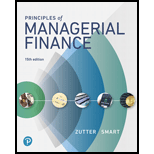
a)
To determine:
NPV of the project.
Introduction:
The difference between the
a)
Explanation of Solution
Given information:
The initial investment for the project is $67,800,000 and it generates an annual
Explanation:
The given information helps us to conclude that the project has a positive NPV and a very high IRR with initial outflow and subsequent cash inflows. Thus, the project should have a cost of capital less than the IRR value.
b)
To determine:
Cost of capital of the firm.
Introduction:
The difference between the present value of cash inflows and the present value of cash outflows over a period of time is known as the Net Present value. Cost of capital is the cost of long term financing of the firm.
b)
Explanation of Solution
Given information:
The initial investment for the project is $67,800,000 and it generates an annual cash inflow of $30,450,000 for 5 years. The project NPV is $44,200,000 and the IRR is 34.8%.
Explanation:
When the initial investment I0 ,annual cash flow (AC), rate of interest r, and the time period n is given NPV can be calculated using the equation (1) ,
By trial and error method let us assume the cost of capital to be 0.11.
When substituting 11%, NPV is $44,740,064. Since the calculated NPV is greater than the given NPV, increase the interest rate 11.19%.
When the interest rate is 11.19%, the NPV is nearly equal to the given NPV $44,200,000. Thus, cost of capital of the firm is 11.19% (approx..).
c)
To determine:
The payback period of the firm.
Introduction:
Every investment requires a time period to pay back the cost of investment. The time period taken to recover the cost of an investment is known as the payback period.
c)
Explanation of Solution
Given information:
The initial investment for the project is $67,800,000 and it generates an annual cash inflow of $30,450,000 for 5 years. The project NPV is $44,200,000 and the IRR is 34.8%.
Explanation:
Payback period for project can be calculated as follows:
The payback period for project is 2 years and 3 months.
Want to see more full solutions like this?
Chapter 10 Solutions
Gitman: Principl Manageri Finance_15 (15th Edition) (What's New in Finance)
- Hello tutor this is himlton biotech problem.arrow_forwardYan Yan Corp. has a $2,000 par value bond outstanding with a coupon rate of 4.7 percent paid semiannually and 13 years to maturity. The yield to maturity of the bond is 5.05 percent. What is the dollar price of the bond?arrow_forwardA trip goa quesarrow_forward
 EBK CONTEMPORARY FINANCIAL MANAGEMENTFinanceISBN:9781337514835Author:MOYERPublisher:CENGAGE LEARNING - CONSIGNMENT
EBK CONTEMPORARY FINANCIAL MANAGEMENTFinanceISBN:9781337514835Author:MOYERPublisher:CENGAGE LEARNING - CONSIGNMENT Managerial AccountingAccountingISBN:9781337912020Author:Carl Warren, Ph.d. Cma William B. TaylerPublisher:South-Western College Pub
Managerial AccountingAccountingISBN:9781337912020Author:Carl Warren, Ph.d. Cma William B. TaylerPublisher:South-Western College Pub Intermediate Financial Management (MindTap Course...FinanceISBN:9781337395083Author:Eugene F. Brigham, Phillip R. DavesPublisher:Cengage Learning
Intermediate Financial Management (MindTap Course...FinanceISBN:9781337395083Author:Eugene F. Brigham, Phillip R. DavesPublisher:Cengage Learning



